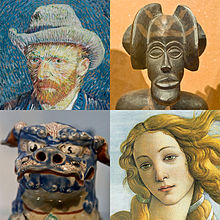
In art, a title is a word or phrase used to identify and distinguish a particular work of art from others. These titles can be descriptive, indicative of the content or theme of the work, or they can be more abstract and open to interpretation. Titles can be designated by the artists themselves, or by curators or other third parties, and can affect reception and interpretation.[1][2]
Traditionally, only works of art in the fine arts are titled, but convenient descriptive titles may be needed for works in the decorative arts, for cataloging, museum labels and similar fields.
It may be discovered or argued that the subject of a work has been wrongly identified. A painting by Titian has been argued to show both Salome or Judith with the Head of Holofernes. The Arnolfini Portrait by Jan van Eyck in the National Gallery has been given several different titles by the museum over recent decades, as opinions as to the nature of the occasion and the people shown have changed.[3]
- ^ Yeazell, Ruth Bernard (2015-09-29). Picture Titles: How and Why Western Paintings Acquired Their Names. Princeton University Press. ISBN 978-1-4008-7346-3.
- ^ Cite error: The named reference
:1was invoked but never defined (see the help page). - ^ The Arnolfini Wedding, The Arnolfini Marriage, the Portrait of Giovanni Arnolfini and his Wife, and other titles
